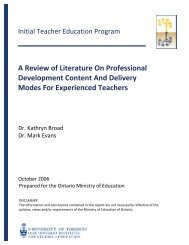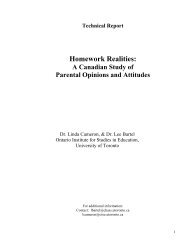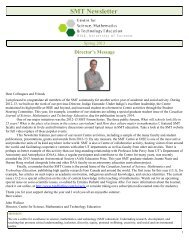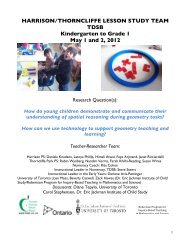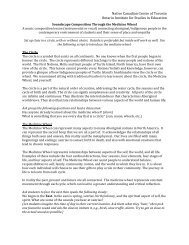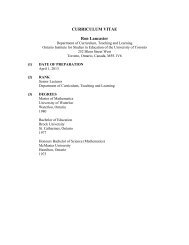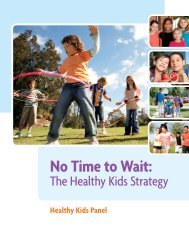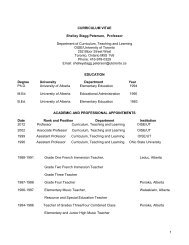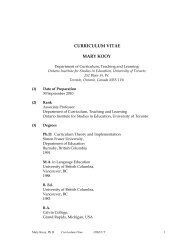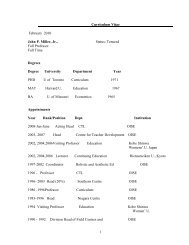The Ontario Curriculum, Grades 9-12 - Ministère de l'éducation ...
The Ontario Curriculum, Grades 9-12 - Ministère de l'éducation ...
The Ontario Curriculum, Grades 9-12 - Ministère de l'éducation ...
You also want an ePaper? Increase the reach of your titles
YUMPU automatically turns print PDFs into web optimized ePapers that Google loves.
A1.6 i<strong>de</strong>ntify province-wi<strong>de</strong> tourist activities and attractions in <strong>Ontario</strong> (e.g., seasonal<br />
festivals, cultural events, areas of natural beauty, historical sites, fishing and hunting,<br />
Aboriginal powwows)<br />
B. Hospitality and Tourism Skills<br />
B4. Planning an Event or Activity<br />
B4.2 <strong>de</strong>sign a tourism event or activity (e.g., reception, ski vacation, fishing trip, catered<br />
event) that meets a customer’s specific needs<br />
C. Industry Practices, the Environment, and Society<br />
C1. Industry Practices and the Environment<br />
C1. <strong>de</strong>monstrate an un<strong>de</strong>rstanding of ways in which various aspects of the tourism industry<br />
affect the environment, and ways in which harmful effects can be reduced<br />
C1.1 <strong>de</strong>scribe ways in which various aspects of the tourism industry affect the environment<br />
(e.g., use of pestici<strong>de</strong>s and fertilizers on golf courses may cause water pollution; air<br />
travel causes increased greenhouse gas emissions through the burning of jet fuel;<br />
Aboriginal lands and traditions may be affected by ecotourism; high water consumption<br />
by hotels may put a strain on the local environment)<br />
C1.2 i<strong>de</strong>ntify ways of reducing the harmful effects that various aspects of the tourism industry<br />
have on the environment (e.g., create wildlife sanctuaries; support conservation projects;<br />
ensure that tourist facilities do not exceed the carrying capacity of the area or region;<br />
invest in carbon offsets such as planting a diversity of native trees)<br />
C1.3 <strong>de</strong>scribe and apply appropriate conservation measures (e.g., reduce, reuse, recycle)<br />
C1.4 <strong>de</strong>scribe, on the basis of research, co<strong>de</strong>s of ethics and/or gui<strong>de</strong>lines for sustainable<br />
tourism, and use them to assess a tourism product, facility, or service<br />
C2. Industry Practices and Society<br />
C2.1 explain the economic and social impact of the tourism industry (e.g., <strong>de</strong>veloping tourist<br />
facilities creates jobs; tourism can cause road congestion, pollution, and/or <strong>de</strong>gradation<br />
of the environment; tourists bring money into the community)<br />
Manufacturing Technology, Gra<strong>de</strong> 10, Open (TMJ2O)<br />
A. Manufacturing Technology Fundamentals<br />
A1. <strong>The</strong> Manufacturing Industry<br />
A1.1 <strong>de</strong>scribe major differences between primary manufacturing industries (e.g., iron and<br />
steel, lumber, paper, petroleum) and secondary manufacturing industries (e.g.,<br />
automotive, aerospace, chemicals, plastics, textiles)<br />
A1.4 <strong>de</strong>scribe ways in which manufacturing technology affects people’s daily lives (e.g., by<br />
providing improved consumer products, <strong>de</strong>veloping new diagnostic equipment in health<br />
care, creating more energy-efficient means of transport)<br />
172 Environmental Education, <strong>Gra<strong>de</strong>s</strong> 9−<strong>12</strong>: Scope and Sequence of Expectations, 2011



